So after the lightning images last night, I went out into the backyard a couple hours later and noticed that the moon was quite bright and clear – the clouds had vanished entirely. The peak of the Eta Aquariids had been the previous night, but the ‘storm’ really lasts for a couple of weeks, or at least, the Earth is in some contact with the debris trail that causes it; how many meteors this actually produces is another matter. Given that the sky conditions have been less-than-optimal all week, I decided to wait until the moon set and give it a shot. And since this occurred after 1 AM this morning, I was up ‘late.’
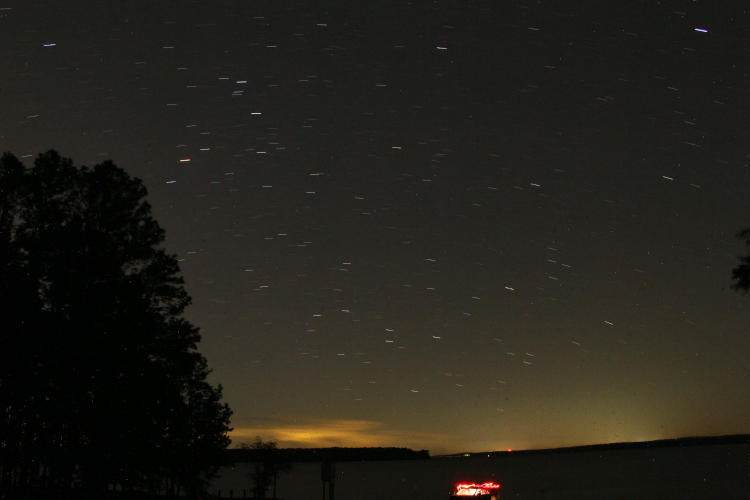
The sky was indeed quite clear, though this didn’t eradicate the light pollution that exists, and Jordan Lake is the closest area with semi-dark skies – this meant that for a short while, I was sharing the area with a kayaker getting ready to do some night fishing. What you’re seeing down at the bottom are the trails left by his red headlamp around his car, though on the horizon you can see the moving tops of some very distant thunderheads. More on this later.
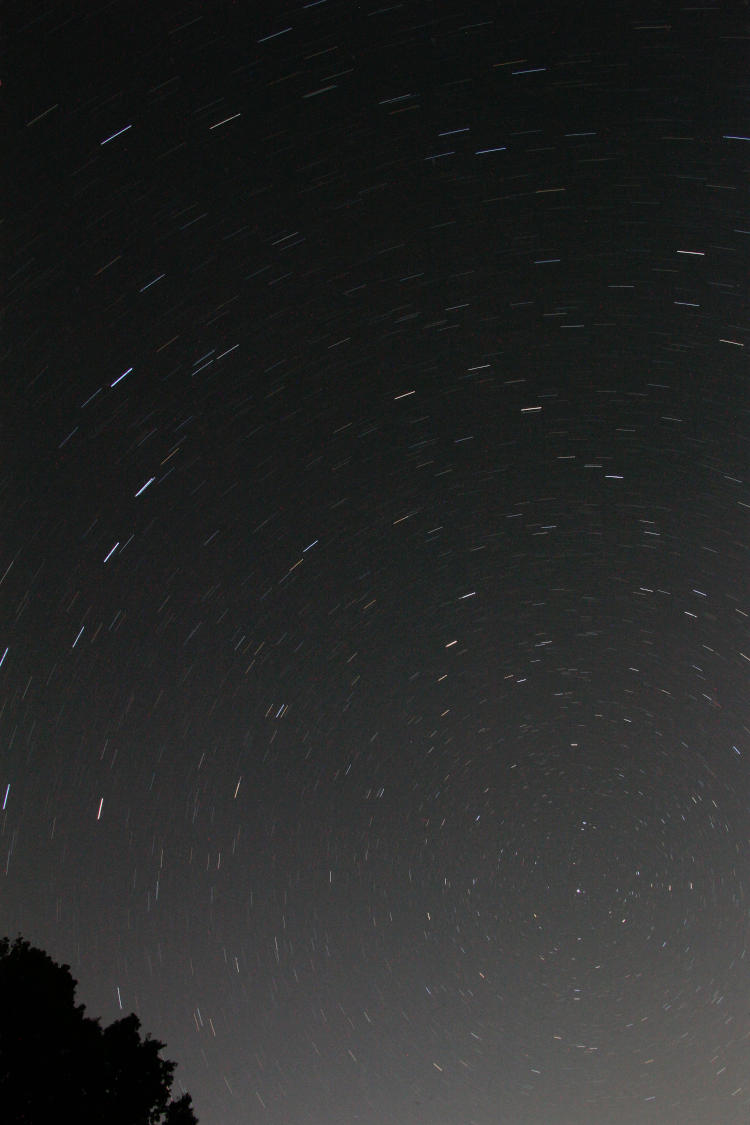
This image shows Polaris, the North Star, at the center of all those arcs, with Ursa Major/Big Dipper off to the left. Note that this is nowhere near Aquarius, the radiant of this storm, but technically that was still below the horizon and anyway, the trees were blocking my view in that direction which is pretty light polluted anyway – I was aiming for the best display regions.
Most of my exposures were around ten minutes, because the lack of humidity meant less light scatter and I could get away with it, and while the camera was just sitting there exposing away, I was scanning around quite a bit, as well as doing some limited exploring until my flashlight battery died. I saw one distinct meteor, though a couple of glimmers out of the corner of my eye may, or may not, have been more. Naturally, the one that I saw was well outside the field of view of the camera, but it did seem to be originating from the direction of Aquarius – it was better than half the dome away though, so far that only a whole-sky image would reveal it seemed to come from there. It was a short and basic meteor anyway, what would have been just a line of light on the image – I’m after the brilliant fireballs, or at least a seriously long trail.
But then, during a short exposure at high ISO, I captured one. Woo hoo.
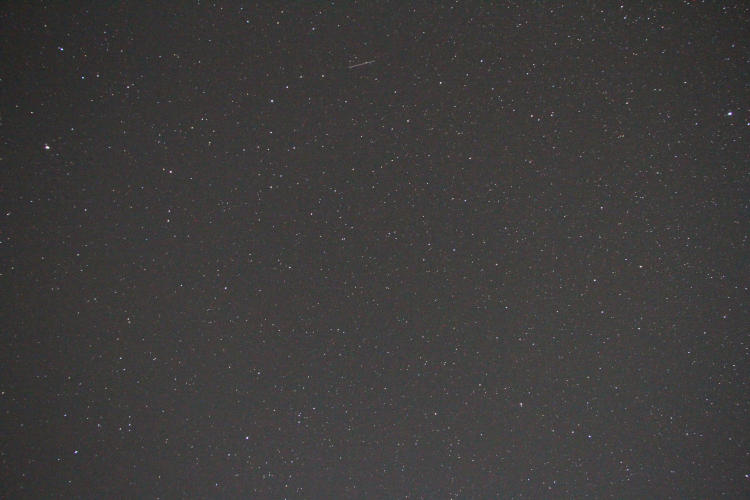
Yeah, that’s it, that little scratch at top center. I need to find some way to note which way I’m aiming during such sessions, because it took a little while to determine that I was facing almost straight up – the bright star at upper right is Vega, the one at upper left is Arcturus, and that curve of stars near the streak is Corona Borealis. The zenith falls just slightly right of center between Arcturus and Vega. I ran Stellarium back after I got home to see if there were any visible satellites around that time and found none, so I was pretty confident that I snagged at least one meteor in-camera for all these attempts – notably, this was only an 18-second exposure.
Then I looked at some other frames.
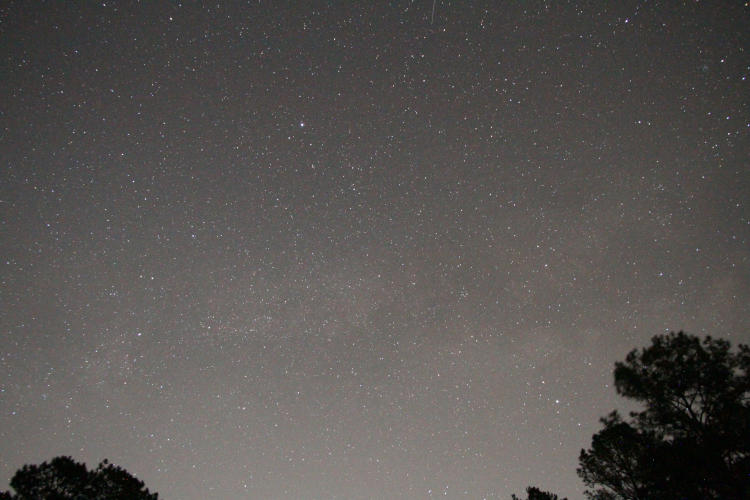
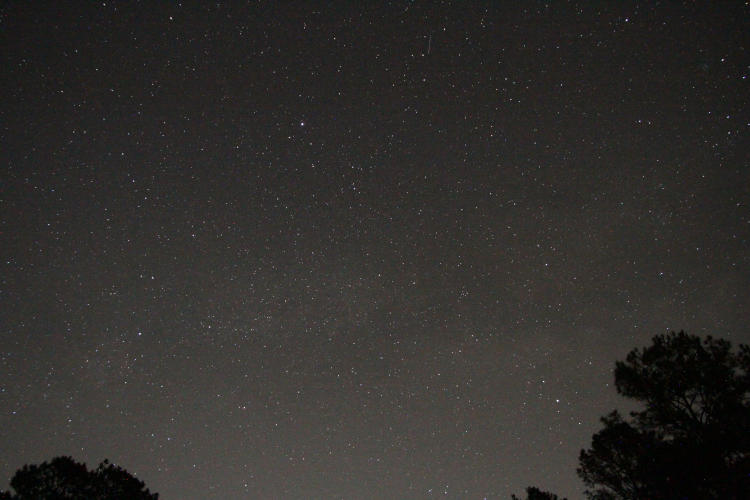
I left these at full-frame, so look closely at top center of both images. These were two minutes after the previous, now aimed almost due east, 18 and 9 second exposures, and the continuity of the trail (not to mention the even brightness throughout, no tapering or change in magnitude) indicates this is a satellite. With Stellarium, it’s very hard to compare orientation, but given the timing and directions, all three are likely the same satellite – I have no record of which, but with the inordinate number of new launches, this isn’t terribly surprising. This means, yet again, no meteors to show for the time spent chasing them. Sigh.
Although, that little cloudiness visible in both frames isn’t humidity, it’s actually the Milky Way, and I decided to pursue that a little better.

I boosted ISO to 6400, the maximum of the camera, and fired off a few test exposures. This one has undergone a slight tweak to contrast (and some camera-noise reduction,) but is otherwise as shot. Man, I really got to get back out to the beach for more attempts without light pollution, because this isn’t half bad for all that. Scorpius is curling up from near the horizon towards the right, which means that the galactic center is sitting there somewhere above that one tree. This is just 9 seconds, so streaking was kept to a bare minimum.
Then I moved into the parking lot further away from the trees, and reoriented a little.
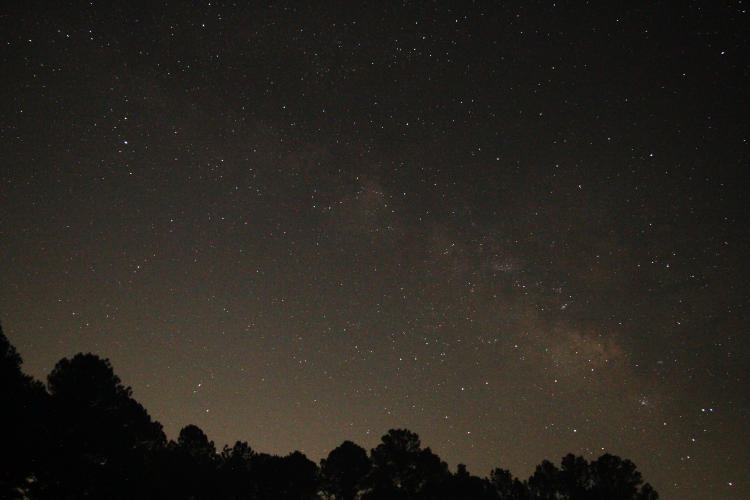
The tail of Scorpius is down there at lower right, and even at 18mm focal length, some of the clusters and nebulas along the Milky Way can be seen. Admittedly, this doesn’t hold a candle to a lot of the images out there, but then again, this has undergone no post-processing at all save for a slight contrast tweak – no multiple-frame stacking or extrapolation, no enhancements, no filters, and so on. These things are de rigueur for astronomy photos anymore, but horseshit as far as I’m concerned, because it’s all computer work – you’ll never see nor capture anything of the sort in-camera, and can only achieve them with specialized software and multiple frames. Imagine what the reaction would be if we did that for any other kind of photography.
Now, I missed a trick myself while out there, only thinking about it after I got back and saw the large amount of chromatic speckling within the ISO 6400 frames. The 7D has a long-exposure noise reduction option, but I’d tried it out and it takes as long, processing within the camera, as the original exposure did; this is obviously a hindrance with ten-minute exposures, especially when chasing meteors, because it freezes up the camera from any other use. But with these ISO 6400 images lasting no more than 20 seconds – that’s doable. I wish I’d thought of it while out there, but I hadn’t yet seen the end results either.
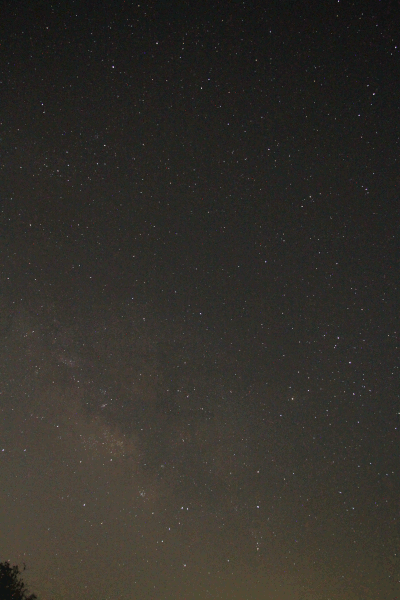 I’m throwing this one down for giggles, because that dark spot has me curious. These were consecutive, 8 and 17 seconds with a couple of seconds between them, and I don’t know how that dark patch got in there. I initially suspected a spot from the earlier rains, shown only by the brightness of the exposure, but it appears in no other frames and I never touched the lens while out there. I think a bug landed on the lens for a few moments.
I’m throwing this one down for giggles, because that dark spot has me curious. These were consecutive, 8 and 17 seconds with a couple of seconds between them, and I don’t know how that dark patch got in there. I initially suspected a spot from the earlier rains, shown only by the brightness of the exposure, but it appears in no other frames and I never touched the lens while out there. I think a bug landed on the lens for a few moments.
I mentioned the thunderheads earlier, and I was seeing little flashes from that approximate direction some time later, figuring them to be distant lightning. So I pulled the lightning tracker up on my smutphone and found that the only strikes were something like 350 kilometers away! So either these carry for a remarkable distance on clear nights, or the tracker doesn’t register cloud-to-cloud activity and thus wasn’t pegging a closer storm, which is fairly likely. It seemed to be in the right direction anyway.
There were also a handful of fireflies cruising around out there, but none of them were inclined to cross the field of view of the camera, which might have been cool. I’ve seen too little firefly activity to try and capture it in a night exposure, but one of these days it’ll happen.
I’d headed down there hoping that my luck would continue after the lightning, and I’d catch an image of a glorious bolide, but no dice this time. And I remind myself, typing this, that the idea of ‘jinxing’ myself by hoping is just as superstitious as thinking there’s such a thing as luck holding. Meteor storms just ain’t been panning out for me – but I’ll catch nothing by not trying, so…




















































